-

人教版高中英语必修4Body Language说课稿4篇
Textbook: Senior English for China (Book 4), by Liu Daoyi Time Allotment: 1 period (40 minutes)Date: March 20, 2014Teaching aids: blackboard, Multi-media, Power Point, chalk I. Text Analysis (教材分析)This unit is about body language, and the text selected in the reading part demonstrates the difference and similarity of body language in many parts of the world. Through learning this passage, students are required to raise their awareness of using body language in different parts of the world. As body language is closely related to our daily life, it is easy to arouse students’ interest in learning this text. Reading skills and speaking training are designed around the text.II. Teaching Objectives (教学目标)By the end of the lesson, students will be able to:1. Language Skill Objective(语言技能目标): develop reading ability (skimming and scanning)as well as speaking ability.2. Cultural Knowledge Objective(文化知识目标): know about the cultural differences of using body language.3. Affective Objective(情感目标): increase students’ awareness of using body language correctly in different cultures. III.Teaching Focuses and Difficulties(教学重点和难点)1. Teaching Focuses(教学重点): the difference and similarity of body language in many parts of the world.2. Teaching Difficulties(教学难点): develop students’ reading abilities of skimming and scanning and ask the students to show their opinions with fluent English.

人教版高中英语必修2Cultural Relics说课稿2篇
Ⅲ. Analysis of the teaching material:The topic of this unit is cultural relics. Students are quite interested in topics about different cultures around the world. This is the second period of the whole unit. As a reading class, the passage mainly talks about the history of the amber room (how it was made, sent as a gift, lost and rebuilt).According to the new national curriculum, when teaching reading, much emphasis should be put on training the students’ reading skills.Ⅳ. Teaching objectives1. Language objectives:1) Students are required to master the key words and phrases occurred in the passage (e.g. amazing, decorate, belong, in return, less than etc.)2) Students are required to learn the attributive clause and acquire the sentence pattern.2. 1) Students are required to describe a certain thing by using the new sentence patterns.2) Students are required to master two kinds of reading skills—skimming and scanning, and learn to use them in their daily reading.3. 1) Students are required to know the history of the amber room.2) Students are required to appreciate cultural relics and understand the importance of protecting them.Ⅴ. Teaching important and difficult points1) the new words, phrases, and sentence pattern in the course of reading.2) Teaching difficult point: Help the students master two kinds of reading skills—skimmingand scanning and learn to apply them in daily use.Ⅵ. Teaching methods:Task-based method & Top-down model Ⅶ. Teaching aids: PPT, pictures, blackboard Ⅷ. Teaching procedure:

人教版高中英语必修2The Olympic Games说课稿2篇
Purpose of my design:To ask the students to do these two tasks will make the Ss predict the story of this passage. As a result, it will deepen Ss’ memory of this story because they will have their own understanding of this story.Step 3. While-readingTask 1. (Individual work _____min)Skimming: ask students to skim the text and the main ideas of each paragraph in this passage. Please read it quickly and then match the sentences with the letters.Task 2. (Individual work _____min)Scanning: read the text quickly and decide the whether the following statements are true or false and give reasons.Task 3. (Pair work _____min)Listen to the tape and fill in the banks. Then read the paragraph with expression to your partner.Task4 (individual work min)Listen to the tape again and write down the main idea in one sentence.Purpose of my design: Enable students to understand the given material better by using different reading skills. And proper competition can arouse the Ss’ interest in English learning. “Task-based” teaching method is used here todevelop the Ss’ ability of communication and also their ability of co-operation will be well trainedStep 4. Post-readingTask 1. (Individual work, pair work, group work, class work; _____min)Discussion (group of 4):1. If you were Hippomenes, would you run against Atlanta?2. Do you think Hippomenes deserved to win the race? Why or why not?Step 5. HomeworkPlease read the story again carefully after class and imagine: What will happen during the race between Hippomenes and Atlanta? Who do you think will win the race? Do you think Atlanta would marry Hippomenes? Write an end for the story with thses questions.Purpose of my design: Homework is so important and necessary for to master the knowledge they learned after class. It will check whether the Ss achieve the teaching aims.Part 5 Blackboard design

人教版高中英语必修4Women of achievement说课稿4篇
Good morning, distinguished judges:It’s my honor to talk about my teaching ideas with you. Today my topic is Women of Achievement. My presentation consists of six parts: the analysis of teaching material and student, teaching aims, key and difficult points, teaching and studying method, teaching procedures and blackboard design.First, let’s focus on the analysis of teaching material. This lesson is from New Senior English for China Student’s Book 4 Unit 1, the reading part. The main topic of the passage is the introduction of a student of Africanwildlife. After this lesson, the students will learn more information about her studying chimps in Africa, and their reading and speaking abilities can be developed as well.The next part is the analysis of students. My students are in senior high students. They have learnt English for many years, they’ve known many words and sentences, but their speaking and reading abilities are still not very good. So I will practice their speaking and reading abilities through different exercises.According to the New Standard Curriculum and the present situation, I set the teaching aims as follows: firstly, knowledge aims. Students can grasp some new words, such as worthwhile, move off. Moreover, students can understand the content of the passage and get familiar with the topic of studying chimps in wildlife. Secondly, ability aims. Students can use reading strategies such as skimming and scanning in reading process. Thirdly, emotional aims. Students can have the awareness of protecting animals and care about animals.Based on the above analysis, the key point of this lesson is to get the main idea and the detailed information from the passage; the difficult point is to talk about the wildlife protection and use reading strategies.

人教版高中英语必修5First aid说课稿6篇
In this class, I have 3 teaching aims, that is, knowledge aims, ability aims and emotion aims.1) Knowledge-Teach students new words and expressions, such as temporary, bleed,sprain choke, first aid, fall ill and so on.-Enable students to have a better understanding for some basic knowledge of first aid.2) Ability-Train students’ speaking, reading and writing abilities by different teaching activities, such as skimming, comprehending, team work, role play, retelling and writing.-Develop students’ reading strategy on how to move general idea to specific information.3) Emotion-Promote students’ awareness of giving first aid.- Cultivate students’ creativities.Then let’s come to my teaching methods and activities.III. Teaching methods and activities:To achieve different teaching aims, various kinds of teaching methods and activities will be adopted throughout this period, such as TBL (task-based learning), skimming, team work, brainstorm and others, which can offer students opportunities to fulfill tasks in which they can use language to achieve a specific outcome.IV. Teaching aids:Computer and blackboardV. Teaching important points:1) Make students have a clear mind for the structure of the text.2) Help students understand the theme of the text.VI. Teaching difficulties:1) So many new words may affect students’ understanding.2) How to get students to know about the functions of the skin and thecauses, characteristics and treatments for different degree burns,and the knowledge about giving first aid. VII. Blackboard design:

人教版高中英语必修5Great scientists说课稿4篇
通过写文章梗概,培养学生综合运用语言的能力,学习用恰当的英语描述科学家的故事。这是本课的教学难点。教师可以使用完形填空的方式来帮助学生整理语篇,从而来降低难度。本课的教学重点的突破方法是:在阅读前,让学生初步了解得出科学观点所需要的基本程序,从而轻松而自然地导入文章的阅读;在阅读过程中,由易到难设计快速阅读和精读的问题,层层推进各种阅读活动,让学生对阅读内容从整体感知到细节理解,最后深层读懂整篇文章,同时加强阅读策略的指导,让每个学生都主动参与课堂教学活动,最终达到提高阅读能力的目的。Step 4 Post-readingGroup Activities四人小组共同合作,在老师的适当指导下,就以下2个问题展开讨论,让学生就所知、所学、所感和所想融入话题,然后抽若干同学代表作小组发言。1. What do you think about John Snow, and what should we learn from him?2. Cholera was 19th century disease, which two diseases are similar to cholera today? Why?

人教版高中英语必修5Life in the Future说课稿5篇
Good afternoon, everyone. It’s my great pleasure to be here sharing my lesson with you. The content of my lesson is Senior English for China Book5 Unit 3 Life in the Future. I’ll be ready to begin this lesson from six parts: Analysis of the teaching material, Analysis of the students, Teaching aims and important and difficult points, Teaching methods and aids, Teaching procedures, and Blackboard design. First, let me talk about the teaching material.Part 1 Analysis of the Teaching Material:This unit is about what human beings’ life will be like in about one thousand years. By studying of this unit, we’ll Enable the students to know the changes in humans’ life and some new inventions bringing about the change and develop the interest in science. This lesson plays an important part in the English teaching in this unit. This is an important lesson in Book Five. From this lesson, it starts asking the Ss to grasp contents of each passage. Therefore, this lesson is in the important position of the teaching material. If the Ss can learn it well, it will be helpful to make the Ss learn the rest of this unit.Part 2 Analysis of the SsAs Senior2 Ss, they are at different levels of English fluency, some of them have lost interest in English. So during the lesson, I arrange a variety of activities to let all of them join in to attract their interest and let them be confident and taste the joy of success.

人教版高中英语必修5Making the news说课稿4篇
今天我们来介绍一下必修五第四单元的授课方式。这个单元的题目是Making the news。应该是学生比较感兴趣的话题,学生往往对新闻工作充满好奇,所以我们可以利用这个机会多设计一些师生互动和学生互动,来激发起学习的积极性,提高学习效率。同时我们可以利用这个单元不仅帮助学生掌握语言知识,培养语言能力,同时让其了解新闻工作的重要性,培养起社会智能感。这个单元分为六个课时,它的教学目标是这样的:语言目标是掌握词汇表中的常用单词和短语,掌握倒装句的一些基本用法。 技能目标是能初步掌握约会的基本句型并在真实的场景下正确运用。新闻报道类文章的写作技能。采访的基本规范和沟通技能。情感目标是对新闻报道的客观性和真实性有更好的理解。对新闻记者的职业有更深入的了解,并能体会其工作的重要性。下面我们来介绍一下第一课时的授课方式,第一课的教学目标是这样的第一课时的教学目标语言目标:单词:Occupation, journalist, editor, photographer, curious, personality, enthusiasm

人教版高中英语必修5The United Kingdom说课稿4篇
Teaching Aims:Knowledge 1. Get the students to learn the useful new words and expressions in this section. Aims:2. Let the students learn about how the UK was formed and the four groups of invaders.1. Develop students’ reading ability and let them learn different Ability reading skills. Aims:2. Enable students to learn to talk about the United Kingdom and the Union Jack Emotional 1. Let students know more about the UK2. Develop students’ sense of cooperative learning Aims:Teaching Important Points:1. Let the students learn about the countries of the United Kingdom and the Union Jack2. Get the students to read the passage and know about how the UK was formed and the four groups of invaders.3. Have the students learn different reading skills.Teaching Difficult Ponts:1. Develop students’ reading ability.2. Enable students to talk about the United Kingdom and the Union Jack.3. Let students learn how the UK was formed geographically and historically.Teaching Methods:Showing pictures, asking, exercising, listening, reading etc.Teaching Aids:A computer,a projector and a blackboard.Teaching Procedures: 1) Show a map of the world, ask students the following questions:Where is the UK?What’s the full name of the UK?2) Ask the students work in pairs to do the quiz on Page 9.Do you want to test how many things you know about the United Kingdom? Let’s have a small test.Using the map on P9, students answer the following questions:?How many countries does the UK consist of? What are they??England is divided into three main areas. Do you know what they are? 1) Scanning (10Minutes )Let the students hold the questions asked in pre-reading and read the passagequickly and then let them do the following exercise.Join lines to the right answer.
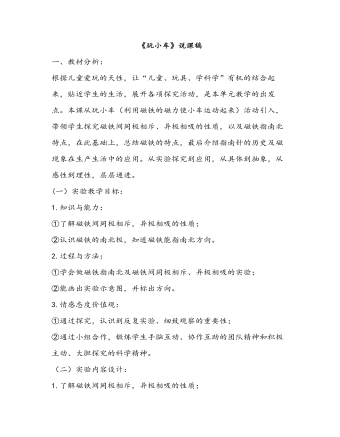
小学科学鄂教版三年级上册《玩小车》说课稿
(一)实验教学目标:1.知识与能力:①了解磁铁间同极相斥,异极相吸的性质;②认识磁铁的南北极,知道磁铁能指南北方向。2.过程与方法:①学会做磁铁指南北及磁铁间同极相斥、异极相吸的实验;②能画出实验示意图,并标出方向。
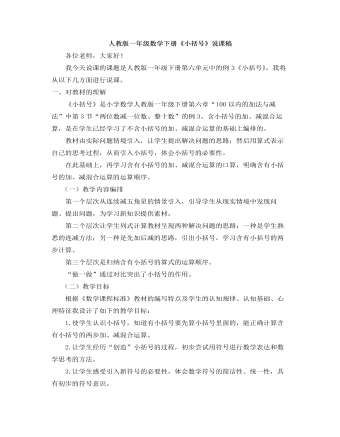
小学数学人教版一年级下册《小括号》说课稿
一、对教材的理解《小括号》是小学数学人教版一年级下册第六章“100以内的加法与减法”中第3节“两位数减一位数、整十数”的例3。含小括号的加、减混合运算,是在学生已经学习了不含小括号的加、减混合运算的基础上编排的。教材由实际问题情境引入,让学生提出解决问题的思路;然后用算式表示自己的思考过程,从而引入小括号,体会小括号的必要性。在此基础上,再学习含有小括号的加、减混合运算的口算,明确含有小括号的加、减混合运算的运算顺序。(一)教学内容编排第一个层次从连续减五角星的情景引入,引导学生从现实情境中发现问题、提出问题,为学习新知识提供素材。第二个层次让学生列式计算教材呈现两种解决问题的思路:一种是学生熟悉的连减方法;另一种是先加后减的思路,引出小括号,学习含有小括号的两步计算。
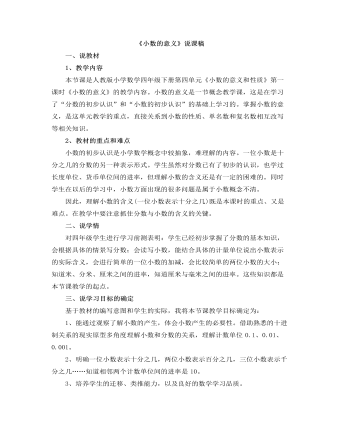
小学数学人教版四年级下册 《小数的意义》说课稿
1、教学内容本节课是人教版小学数学四年级下册第四单元《小数的意义和性质》第一课时《小数的意义》的教学内容。小数的意义是一节概念教学课,这是在学习了“分数的初步认识”和“小数的初步认识”的基础上学习的。掌握小数的意义,是这单元教学的重点,直接关系到小数的性质、单名数和复名数相互改写等相关知识。 2、教材的重点和难点小数的初步认识是小学数学概念中较抽象,难理解的内容。一位小数是十分之几的分数的另一种表示形式。学生虽然对分数已有了初步的认识,也学过长度单位、货币单位间的进率,但理解小数的含义还是有一定的困难的。同时学生在以后的学习中,小数方面出现的很多问题是属于小数概念不清。因此,理解小数的含义(一位小数表示十分之几)既是本课时的重点、又是难点。在教学中要注意抓住分数与小数的含义的关键。
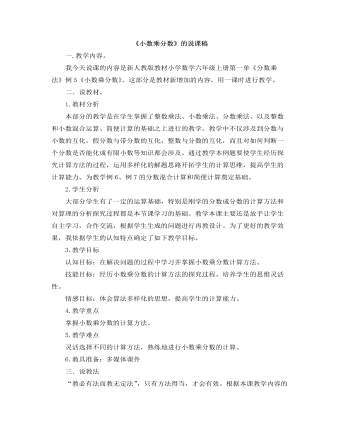
小学数学人教版六年级上册《小数乘分数》说课稿
一.教学内容。我今天说课的内容是新人教版教材小学数学六年级上册第一单《分数乘法》例5《小数乘分数》。这部分是教材新增加的内容,用一课时进行教学。二.说教材。1.教材分析本部分的教学是在学生掌握了整数乘法、小数乘法、分数乘法、以及整数和小数混合运算、简便计算的基础之上进行的教学。教学中不仅涉及到分数与小数的互化,假分数与带分数的互化,整数与分数的互化,而且对如何判断一个分数是否能化成有限小数等知识都会涉及。通过教学本例题要使学生经历探究计算方法的过程,运用多样化的解题思路开拓学生的计算思维,提高学生的计算能力。为教学例6、例7的分数混合计算和简便计算奠定基础。
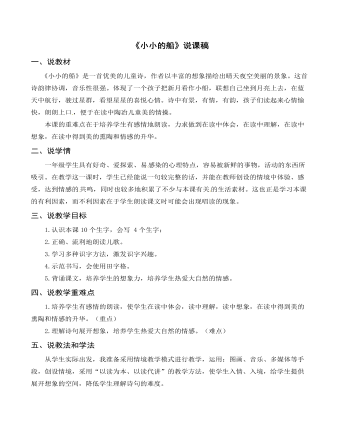
部编人教版一年级上册《小小的船》说课稿
(2)综合运用图画、语言、音乐,再创情境。(教师描述)如果现在是夜晚,我们一起坐在院子里,抬头看天空,蓝天上有星星,有月亮。这弯弯的月亮,它多像一艘小船呀!(播放背景音乐)现在请大家听着音乐 轻轻摆,慢慢地闭上眼睛。想着,想着,你是不是坐在月亮上了?是不是飞上蓝天了?(此时学生会情不自禁说自己已经飞上蓝天,已经坐在月亮上了。)当学生睁开眼睛,(师播放课件)哈,小朋 友现在我们已经飞上天了,已经坐在小船里了,让我们在月亮上愉快地唱起《小小的船》(播放儿童歌曲《小小的船》),伴随着歌声的响起,学生就会进入美妙的境界。教师随即出示句式:我看见了____________________________________。引导学 生说出:宇宙飞船上天,航天飞机登上月球等。接着再用“蓝蓝的天”进行说话训练。例如蓝蓝的天上有什么?我在蓝蓝的天上干什么?不难看出,在理解重点句子时,根据创设的情境,让学生充分展开想象的翅膀,学生往往为此而兴奋不已,学生情绪为之高涨,进入一个高潮。此举极大地丰富了课文内容,学生的学就乐在其中,悟也在其中。
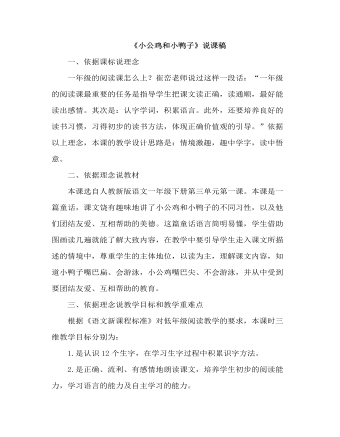
部编人教版一年级下册《小公鸡和小鸭子》(说课稿)
三、依据理念说教学目标和教学重难点根据《语文新课程标准》对低年级阅读教学的要求,本课时三维教学目标分别为:1.是认识12个生字,在学习生字过程中积累识字方法。2.是正确、流利、有感情地朗读课文,培养学生初步的阅读能力,学习语言的能力及自主学习的能力。3.巩固识字的方法,体会朗读的方法。4.从课文中受到要团结友爱、互相帮助的教育四、说说学生一年级学生具有天真活泼,好奇好问,好模仿易感染的心理特点,容易被直观形象、新鲜活动的事物所吸引,并能在教师创设的情境中获得体验,达到情感共鸣、因此在教学中,我根据学生的身心特点设计情境,设计游戏,分解朗读要求,分散识字难点,让学生在一堂课中能始终学得轻松,学得愉快。五、说说教学策略方法1、 创设情境法。创设故事情境,让学生切身投入到情境中去。2、 趣味识字法。用赛读排火车等方法巩固识字。3、 以读促悟法。指导朗读,边读边悟。

部编人教版一年级下册《小公鸡和小鸭子》说课稿
一、教学要求1、会写7个生字。2、会认13个字。3、正确、流利、有感情地朗读课文。通过朗读课文,知道鸭子和公鸡的不同习性,懂得小伙伴之间要互相帮助。二、教材说明本课是一篇童话。讲的是小公鸡跟小鸭子一起玩,小公鸡给小鸭子捉虫子吃,小鸭子给小公鸡捉鱼吃。小公鸡下河后差点被淹死,幸亏小鸭子救了它。课文饶有趣味地讲了小鸡和小鸭的不同习性,以及它们团结友爱、互相帮助的美德。三、教学建议(一)教学准备准备本课的生字词语卡片、放大的课文插图、多媒体课件及朗读课文的录音带。(二)识字、写字教学学习生字。重点指导读准“他、河、说”和要求会认的字“块、捉”的音。
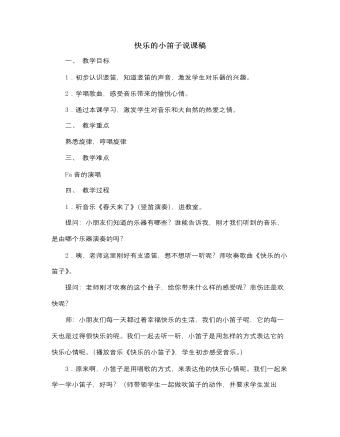
人音版小学音乐一年级上快乐的小笛子说课稿
9.恩,小朋友们唱得不错,但是,我觉得你们可以唱得更好!这样,小笛子和大鸭小鸭会玩得更开心!现在,脚放平,背坐直,带着愉快的心情,我们再来一次。10.今天最大的难题来了,小朋友们想不想挑战一下自己呢?好的,请你跟我这样唱,(教唱旋律,分两大组合作)11.同学们今天的表现实在是太棒了!比小笛子的歌声更美妙,更动听!老师希望我们每一位小朋友,都像快乐的小笛子一样,永远唱着快乐歌,快乐成长!让我们和小笛子一起,唱起来吧!(播放音乐,结束本课)。教学反思:快乐的小笛子是一年级上册第八课的一节唱歌课,歌曲非常欢快活泼,音乐里面加入了小鸭的叫声,非常具有童趣,学生都很感兴趣。但是这首歌曲速度比较快,很多学生一开始跟不上歌曲的节奏,显得手忙脚乱。所以我设计了吹笛子环节,让学生模仿小笛子的声音与动作,并进行形式的变化,如个人演奏、两人合奏,小组竞赛等形式,让学生非常感兴趣。学生很快就掌握了歌曲的难点,学生在快乐中学会了歌曲。
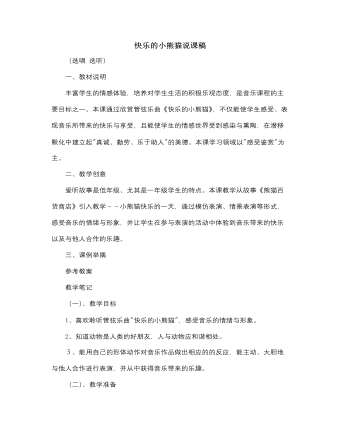
人音版小学音乐一年级上快乐的小熊猫说课稿
(时间不早了,森林里顿时热闹起来,小动物们在干什么呢?)·聆听: 听音乐第二段,感受音乐轻快的情绪。生根据自己对音乐的理解与想象回答。然后再视听结合,播放小鸟飞、在大树上叽叽喳喳的情景,进一步感受此段音乐特点,并随音乐表演。(小熊猫也出发了,看!哥弟俩抬着水桶去打水呢)。·听赏音乐第三段。感受活泼明快的"熊猫主题"。·鼓励学生模仿小熊猫打水、抬水的样子,并随音乐表演,体验音乐所表现的情绪与形象。3、完整聆听多媒体完整播放音乐及画面,学生整体感受音乐所描述的情景,同时培养学生良好的聆听音乐的习惯。4、情景表演学生选择自己喜欢的头饰,扮演动物角色,分小组随音乐进行情景表演,体验音乐带来的乐趣及与他人合作的快乐。5、评价反思、德育渗透。(四)、其他选择1、本课开始部分可用猜谜语导入。2、教师可以先让学生完整欣赏音乐,让学生根据音乐想象描述的情节,再分段欣赏。
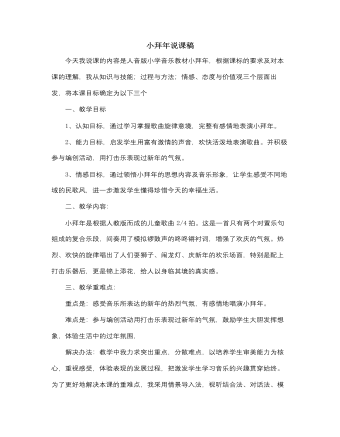
人音版小学音乐一年级上小拜年说课稿
1、为音乐配打击乐打击乐器是小学生喜欢的乐器。让学生在音乐课上演奏打击乐器,不但可以提高学生的学习兴趣,同时也能培养对音乐的感知力。让学生为乐曲加上打击乐器伴奏。在鼓、钹声中,学生的参与意识被激发。加强了学生对音乐的理解,增强了音乐的表现力。(五)拓展延伸 。 1、让音乐与生活沟通起来音乐本来就是从生活中创造出来的。我们在音乐教学过程中根据教学需要,实现教师、学生、教材、教具、教学环境与生活的多方面横向联系,及他们之间的相互作用和影响。 (六)、课堂小结。课堂小结:是在完成某项教学任务的终了阶段,教师富有艺术性的对所学知识和技能进行归纳、总结和升华的行为方式,它常用于课堂的结尾,所以形象地被称作"豹尾"。完善、精要的"小结",可以使课堂教学锦上添花,余味无穷,让学生达到前后浑然一体的美妙境界,以激发学生学习音乐课的热情,同时性情也受到熏陶。
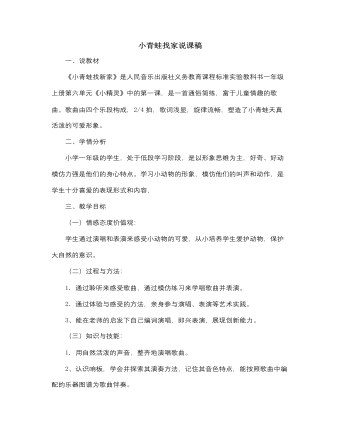
人音版小学音乐一年级上小青蛙找家说课稿
(三)、学唱歌曲本环节通过学生聆听录音范唱让学生初步接触歌曲,感受音乐形象。通过学生熟悉歌曲,模仿小青蛙的叫声,用听唱法学习歌曲,教师用电子琴纠正唱不准的地方,慢慢学会演唱歌曲,通过启发,用声音和动作处理歌曲并能声情并茂的唱歌。(四)、为歌曲加入伴奏让学生自己观察响板,探索其演奏方法,再根据图片上的图谱用打击乐器为歌曲加入伴奏。(五)、创编歌词这个环节体现本课的另外一个难点,教师用生动的语言将孩子的思维再次打开,请他们通过模仿其他小动物的声音填词歌唱,培养了学生的想象力和创造力,使课堂气氛更加的生动活泼。七、本课小结先让学生说说本节课的收获,教师再做最后的总结,教育学生要爱护动物保护动物,做动物的好朋友,渗透德育教育。最后在歌声中结束本课。